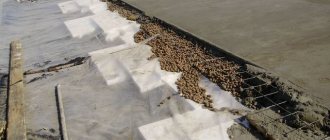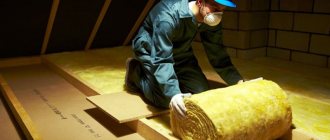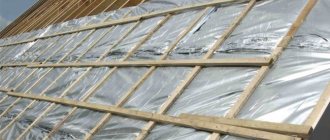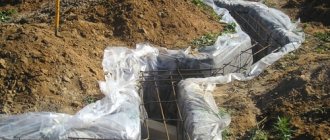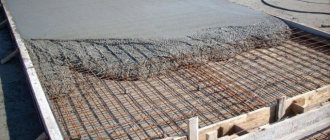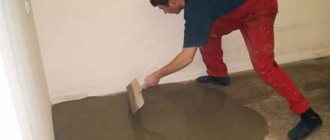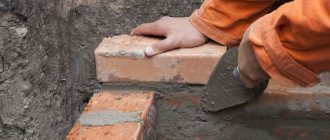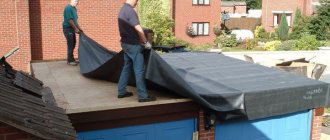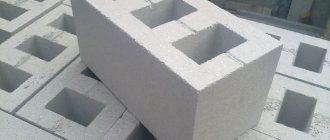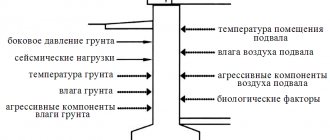Garage roof waterproofing materials
Resistance to moisture is the most important characteristic, due to which liquid and roll waterproofing are used. Water and steam should not leak through the applied layer of waterproofing coating on a concrete roof.
The elasticity of the material will prevent the destruction of the integrity of the coating due to deformation of the structure. Elasticity will protect the roof from moisture, even when the load on the insulation layer and the roof surface is significant.
The strength of the roof waterproofing layer is also important, since the structure is often subjected to loads of various types. High-quality material is able to withstand various deformation processes during operation.
How to waterproof a garage roof
The most popular waterproofing materials at the moment are roll and liquid types of waterproofing. Rolled materials are easy to use, have a low cost and are often used when waterproofing a garage roof under corrugated sheeting is required. Polymer mastics and liquid rubber are most often used when processing vertical structures of various structures.
Quite often, experts combine different types of waterproofing. For example, a flat garage roof is first covered with roofing felt, and at the joints the surface is treated with mastic. The mastic is easily applied to any surface, providing reliable protection from moisture, and such a moisture-proofing layer will last an order of magnitude longer than simple bitumen or roll analogues.
High-quality waterproofing of the garage roof with roofing felt or mastic, inside and out, will protect the room from dampness and moisture. This will protect the car in the garage from unwanted corrosion processes. In the next chapter, we will look at how to properly waterproof a garage roof with your own hands, using roofing felt, mastic and liquid rubber.
We waterproof a concrete roof
High-quality waterproofing of a garage roof with your own hands is a completely doable task if you act correctly and use reliable materials. Let's look at the features of working with concrete garage roofs.
You need to start with insulating the garage space. Extruded foam is now a good solution. The material allows you to achieve an optimal balance of quality and price: it has an affordable cost, is simple and convenient to install, has decent strength, resistance to mechanical stress and compression.
- The concrete base of the roof must be thoroughly cleaned.
- At the next stage, the roof is primed with a frost-resistant compound.
- Insulation is carried out with foam plastic. You can fix sheets of material using special glue.
- To make the fastening more reliable, it is advisable to use special elements, for example, “umbrellas”.
- Make the surface of the insulation layer continuous. For this, you can choose foam sheets with grooves or quads, which will ensure the elimination of all cold bridges. If you have already purchased material with smooth edges, you need to install the sheets with small gaps. Then all that remains is to fill them with polyurethane foam to perfectly secure and strengthen the insulation.
- A sand-cement mixture screed is placed on top of the foam insulating layer. Maintain a layer thickness of approximately 3-4 cm.
- Now it's the turn of the mastic. You can use modern polymer mastic. It is also commonly called “liquid rubber”. Be sure to strictly follow the instructions: the application method is described in detail there. There is no universal method, so it is extremely important to follow all the manufacturer’s recommendations.
- When you have already treated the garage roof with mastic, it’s the turn of roofing felt. Fused material rightfully occupies a leading position among waterproofing means. The roll is rolled out over the surface of the roof with fusing. A gas burner is required.
- During the installation process, carefully monitor the coating indicators. The sheet material is heated evenly until they disappear.
- Then you need to let the coating cool completely.
All! You have a reliable waterproofing layer ready for your concrete garage roof. Fused roofing felt will reliably protect the roof from precipitation.
How to waterproof a garage roof
Let's first consider the option of roof insulation using roofing felt. Whatever material you use, first you need to prepare the base by removing the old coating. The entire surface of the roof should be checked for the presence of cracks and cracks, leveled if necessary with cement-sand mortar. All dust and construction debris from the surface should be swept away with a broom or brush.
Waterproofing a garage roof with roofing felt
A cement screed with a slope of up to 4 degrees is placed on the cleaned surface so that precipitation does not accumulate on the roof in puddles, but flows down. After the screed has hardened, the surface of the flat roof is covered with a layer of bitumen emulsion. At the final stage of the work, roofing felt is laid, and experienced builders recommend laying at least three layers of roofing felt.
When rolling out the roll on the roof, it is necessary to heat the underside of the roofing material with a kerosene burner so that the insulation is securely attached to the surface. The sheets should be laid together with an overlap of 10-15 mm, and the strips of the next layer of roofing material should completely overlap the joints of the lower layer. Only in this case will water not reach the concrete slab through the laid insulation.
Waterproofing garage roof with mastic
Polymer mastic has high elasticity and does its job well at low and high temperatures. The film on the roof of the garage can resist the effects of precipitation and sunlight. However, during operation, it is important to exclude exposure of polymer mastic to such chemicals as kerosene, gasoline, alkali, acid and motor oils.
Do-it-yourself garage roof waterproofing with mastic is done in two layers, which will eliminate the possibility of untreated areas appearing on the surface. To apply liquid compounds, you will need a paint brush or roller, as well as gasoline or solvent in case it is necessary to dilute the mastic to a more liquid state. Vulcanization of mastic occurs under the influence of atmospheric air.
Waterproofing garage roof with liquid rubber
Liquid rubber (bitumen-latex emulsion) has high adhesion to any material, and the material can be sprayed onto any surface and even waterproofed a metal garage roof. Once liquid rubber is applied, it hardens to form a durable, flexible and seamless waterproofing coating on a brick garage that will last for decades without leaking.
Before spraying liquid rubber, the garage roof should be prepared: remove old coating, construction debris and remove dust from the surface. The material can be applied by spraying using an airless installation or manually using a roller or brush. Spraying allows you to increase the speed of work and reduce mastic consumption, but significantly increases the cost of work.
How to do it?
The process begins with planning . You need to create a multi-layer system that will reliably protect the garage from precipitation. In cross section, such a system is very similar to a pie, since it consists of several horizontal layers.
Place the moisture-proof material in the middle, but first install the rafters and make the sheathing. Then put a vapor barrier and insulation. Only then can you put on a moisture-proof film.
Garages most often have flat roofs made of concrete or pitched roofs.
Waterproofing a pitched roof
waterproofing process in this case is done as follows:
- First lay the inner lining, then take the vapor barrier material and lay it down.
- Buy the material that you are going to use as insulation . Place it on a vapor barrier membrane. Only after this can waterproofing be done.
- When it is ready, make a counter-lattice and lay the sheathing. The process will be completed by laying the roofing material .
Flat roof waterproofing
In this case, the insulation is placed between the rafters.
- A vapor barrier membrane is placed under the material, and waterproofing is done on top of the insulation . Lay the vapor barrier overlapping. Buy a special connecting tape and carefully glue all the joints.
- If you have a garage in a co-op, it has a pitched roof. The roof has a slight slope; reinforced concrete slabs are used for its construction. Before installing a protective layer, be sure to determine the type of roof, this is of great importance.
- If the roof is level , first apply a frost-resistant primer to the surface. It will penetrate deep into the surface. After this, put insulation, for example, polystyrene foam . In order to securely fasten the insulation, use umbrella dowels. Another method of fastening involves the use of glue.
- Make a screed . Use a mixture of sand and cement for this purpose. For a garage, it is enough to pour a layer 4 cm thick. Wait a few days, the concrete screed should dry completely. Only after this can further work be continued.
- Buy a primer or bitumen-polymer mastic. Apply it over the screed. Waterproofing can be done using guided materials, these are sold in rolls.
REFERENCE: Do-it-yourself liquid waterproofing of a garage roof is a reliable solution .
If the garage roof has a large slope, then it is not recommended to use guide materials and mastic. Buy film material , it is placed on top of the insulation.
Waterproofing a ventilation pipe on a garage roof
It is necessary to plan and think through ventilation in the box at the construction stage. Natural garage ventilation is a simpler method. It's very easy to make. It is necessary to make two holes on one wall of the building at a level of 20-30 cm from the floor for air flow from the street. An exhaust hole should be made on the opposite side of the box or a pipe should be brought to the roof of the garage.
It is recommended to equip the pipe and ventilation holes with a metal mesh to prevent the penetration of rodents. The lower part of the exhaust pipe should be installed 20-30 cm before the ceiling. Waterproofing the pipe on the roof of the garage is necessary to protect it from corrosion, since it will be exposed to precipitation and exposure to moist air from inside the room.
(5,00 out of 5)
Preparing the garage roof surface for waterproofing
The most correct way is complete preparation with clearing of old waterproofing elements. Many people ignore this requirement, due to which at first glance they get a good and new waterproofing layer, but under it there are a lot of stones, cracks, air holes, cavities with moisture and fungus, protruding reinforcement and other problems that spoil the coating already at the moment of rolling it onto the surface . Elementary damage received during the installation of the covering is holes due to the movement of craftsmen on the roof. And, if there are stones or reinforcement under the flooring, there will be quite a lot of them. The result is leaks already during the first rain, water getting under the coating and major repairs next season, if not a complete renewal of the coating.
You can open the air holes, fill them with bitumen-polymer mastic, melt them, sweep away stones from the surface. But it is better to completely clean the roof to find and repair numerous other damages that were previously invisible!
- Surface cleaning: collecting stones, debris, loose parts of bitumen and concrete, and falling out of plaster joints. Packing all garbage into bags and lowering it down to the ground;
- Thorough cleaning of the roof down to the base. You can use scrapers for this. If the old bitumen does not come off, it can be heated with a burner;
- Leveling the surface. It is necessary to knock down all the growths formed by spilled concrete and plaster mortars in the past. Also, it is worth repairing all potholes with a repair compound, having previously primed the surface;
- All seams between the slabs on the garage roof are subject to repair. They are sealed with polyurethane foam and plaster. It is also acceptable to work differently, when the seams are filled with polystyrene foam, polyethylene foam and then plastered and sealed with waterproofing mastic;
- After the first stages of preparation, the roof surface is filled with primer, which is stretched with a brush or roller. The layer should be thin, but applied very evenly to fill all cavities, covering the entire surface of the concrete;
- The second layer of bitumen primer is applied after the first has completely dried, preferably the next day or every other day. The primer rolls out perpendicular to the previous layer!
Why do you need roof waterproofing?
The roof, more than other elements of the garage structure, is exposed to the negative influence of the environment. It rains and snow falls on it, and is affected by heat and ultraviolet radiation from the sun. By and large, it is the roof that protects the structure from moisture and prevents premature destruction of the materials from which it is built.
Typically, a garage roof consists of wooden and/or metal beams, a concrete slab, insulation, sheathing, and cladding sheets. Roofing materials are the first to take the blow of the elements and resist it, preventing water and wind from entering the under-roof space. But even the highest quality ones are unable to provide 100% protection to the wood and metal underneath.
Humid air will have its detrimental effect. As air masses cool, condensation forms, causing wood rot and metal corrosion. Therefore, all structural elements must be properly waterproofed. If you miss this moment, negative consequences are inevitable:
- the service life of the structure will be significantly reduced;
- dampness will appear inside the garage with all that it implies: fungus or mold;
- the smell of rotting wood will be in the room;
- mustiness appear.
The situation will be aggravated by the lack of natural or forced ventilation.
Waterproofing options
The traditional way to waterproof a garage roof is to lay a waterproof soft roof . These are roll or sheet materials, among which the most popular is roofing felt. It serves well for several years and gradually begins to deteriorate. Therefore, such protection from moisture should be considered temporary.
Roll roofing and waterproofing
Roll roofing is the second most popular material for waterproofing a garage roof. This is despite the fact that this type of coating requires repair more often than others due to the high risk of leaks. There are several reasons:
- the junctions with structural elements have been processed incorrectly;
- mechanical impact (the coating is often damaged by children or animals running on the roofs);
- non-compliance with the technology of laying deposited materials.
In Russia, the most popular manufacturer of roll roofing is TechnoNikol. The company offers a wide range of products of this profile, which are not easy for a beginner to understand. In fact, everything is quite simple: all rolled materials consist of a bottom layer of bitumen and a base: cardboard, fiberglass or fiberglass. The latter is the strongest and most durable.
The choice is not only about this. Roll materials are produced in two types with appropriate markings:
- roofing (“K”);
- lining (“P”).
The former should form the top layer of the roofing pie, the latter – the bottom. The most commonly used materials are listed in the table:
All other rolled roofing materials are variations of those listed. The main advantage of bitumen sheets is absolute moisture resistance. There are other advantages:
- no noise when it rains;
- simple installation;
- minimum waste;
- light weight.
But the only “minus” negates all the advantages. It consists in instability to mechanical stress. Roll roofing is easily damaged by sharp objects and leaks.
Attention! Rolled materials with a top water-repellent backing last several times longer.
Coating
Coating waterproofing is a bitumen-based mastic, which is a thick, viscous and plastic composition. After hardening, it forms a durable moisture-proof layer, one of the advantages of which is durability. According to application technology, two types of coating waterproofing based on petroleum bitumen are distinguished:
- hot (heating required before use);
- cold.
The composition of the mastic is a mixture of bitumen with fillers in the form of fibers or solid dust particles. The most reliable are those containing crumb rubber. They have their own name - bitumen-rubber. There are polymer-based mastics, but they are less durable than bitumen ones.
The technology for applying coating waterproofing is no different from the process of painting surfaces . The same tools are used: brushes and rollers. The layer formed by hardened mastic is non-hygroscopic, but unstable to hydrostatic pressure. That is, if it is exposed to water pressure for a long period of time, it will leak to the protected surfaces.
Advice! To prevent this from happening, a layer of a two-component polyurethane mixture of the “Urepren” type is applied on top of the mastic.
The best coating waterproofing for garage roofing from TechnoNikol:
- “MGTN No. 24”, which contains petroleum bitumen and mineral filler;
- “TN No. 20” – bitumen-rubber mixture;
- “TN No. 33”, made from bitumen, latex and emulsifiers;
- AquaMast, bitumen-rubber.
Coating waterproofing is applied to concrete, brick, and stone surfaces. It does not process wood or metal.
Sprayable
Sprayed waterproofing requires special mobile installations that supply the bitumen mixture under pressure. The process is similar to painting surfaces using a spray gun. The layer thickness must be at least 2 mm.
For machine application, mixtures of domestic (TN No. 33 from TechnoNikol) and foreign production are used:
- Liquid Rubber Daclar;
- RubberFlex-55;
- CreteSafe B-250.
The installation of sprayed waterproofing is complicated by the need for specialized equipment. Therefore, this method is not used often, but it is optimal for flat and pitched roofs of metal garages.
Advice! If it is not possible to make sprayed waterproofing, choose coating.
Film waterproofing is a rolled material. Foreign-made products are often called “geomembranes”. These are materials with a thickness of 0.2-1 mm. Domestic ones are thinner - 0.2-0.4 mm. In different sources, waterproofing materials of this type are called differently: films or membranes. All these are the same type of products that perform the same task - preventing the penetration of water to the protected surface.
An important criterion for choosing a film is the service life, which is guaranteed by the manufacturer . The most durable are reinforced ones, consisting of several layers. If you choose the film method of waterproofing the garage roof, then you should not save on the membrane. It is laid for a long time; the sheathing for facing roofing material is stuffed over it. Therefore, it will subsequently be difficult to eliminate coating defects and leaks.
Another important selection criterion is vapor permeability. Not all waterproofing films have this. For example, ordinary polyethylene does not have it. If insulation is provided on the roof, the membrane must allow steam to pass through. Otherwise, dampening of the insulation is inevitable.
Recommended film materials:
- perforated polyethylene;
- reinforced membranes;
- polypropylene films;
- “breathing” or diffuse membranes.
The most suitable materials for film waterproofing of a garage roof
Design Features
A garage is usually a single structure or attached to the main house, used for the maintenance of vehicles and seasonal storage of things. Most often, its roof is a simple pitched, flat or gable structure. Affordable rolled materials, corrugated sheets, and roofing membranes are most often used as a finishing waterproofing coating. The garage roof design has the following features:
- Minimum slope. As a rule, a garage roof has a slight slope. Most often, flat structures are used, the creation of which uses bitumen mastic or roll materials. This parameter significantly limits the choice of roofing coverings.
- Small area. The roof of a garage is usually small in size, so it is more rational to use rolled and liquid waterproofing materials overlapped on each other for the covering.
- High snow load and susceptibility to leaks. Due to the small slope, the garage roof is at increased risk of leaks, so it requires additional waterproofing.
Garage flat roof installation
Pitched garage roof
Note! In order for the garage roof to last longer, it must be multi-layered. Such popular roofing materials as roofing felt and roofing felt are laid in 4-5 layers with overlap between them to achieve an airtight coating. To treat the seams, bitumen-based mastic is used, which is used to coat the joints between the layers and prime the base of the roof.
Required materials and tools
The choice of tools for performing waterproofing work depends on which method is preferred. To install a built-up roof you will need:
- burner and propane cylinder, reducer, hose (blowtorches quickly become clogged and require cleaning, consume a lot of fuel);
- brushes and scrapers for cleaning the floor surface;
- a special stick or homemade device for rolling out a roll;
- vacuum cleaner for removing dust from the surface;
- sharp knife for cutting cloth;
- ax (required for cutting down old roofing);
- wrench for tightening connections;
To install coating waterproofing you will need:
- brush type "maklovitsa";
- roller with a fur coat;
- a tray for a roller or a sheet of metal, a flat piece of wood;
- spatula with a metal blade;
- metal container for preparing “hot” mixtures.
To install film waterproofing you need:
- hacksaw;
- construction stapler and staples;
- silicone moisture-resistant and antibacterial sealant;
- sharp knife;
- drill;
- wood screws;
- lumber for constructing counter-lattice;
- scrapers, brushes and rags for cleaning surfaces.
Advice! Gloves will be required to perform waterproofing and other work.
Preparatory work
Regardless of which method of waterproofing the garage roof is chosen, it is necessary to carry out a complex of work to prepare the surface. It consists of several stages:
- They remove the garbage.
- If there is vegetation, it is removed.
- Remove the old roof covering.
- Clean the roof from dirt and dust.
If the top floor of the garage is a hollow-core slab, you need to carefully inspect the surface for cracks and cavities. According to SNiP, the total area of defects should not exceed 20% of the total . Therefore, if necessary, all cracks and cavities are expanded, dusted and sealed with a cement-sand mortar prepared in a 1:3 ratio (1 part M400 cement and 3 parts sifted sand).
Important! Waterproofing is carried out only on a clean, dry surface. If, after removing the old roofing covering, there are damp spots, the roof must be dried. To protect from precipitation, a canopy with plastic film is built over it.
Garage roof: DIY waterproofing
You can improve the condition of a concrete garage roof using such a common material as roofing felt. To work, you will need a cement-sand mortar to level the surface, spatulas, brushes, a knife for cutting the canvas and a roofing gas burner. To secure the roll material, you will need a bitumen emulsion.
Before starting work, prepare the foundation. The concrete surface is cleaned of dust, and the metal roof is cleaned of old paint or deteriorated waterproofing layer.
Further steps for arranging the garage roof:
- Creating a screed with a slope of up to 4 degrees to ensure free fall from the roof of precipitation. To do this, make a cement-concrete mortar, which is applied to the surface with a spatula, leveling and checking the angle of inclination.
The cement-concrete mixture must have a slope to naturally remove precipitation from the roof
Video: recommendations for laying roofing felt
Garage roofs are waterproofed using a variety of materials, and the key to the durability of the coating is proper preparation of the base. In this case, it is necessary to take into account the type of roof and select the best options for protecting it from moisture and precipitation.
DIY instructions for waterproofing a garage roof
The simplest and most convenient way to waterproof a garage roof is by wrapping it . Manufacturers offer a wide range of rolled materials with a bottom sticky layer that does not require heating with a gas burner. Thus, it is possible to make high-quality waterproofing without the use of expensive equipment and materials. This method is optimal for flat and pitched roofs of iron, concrete and brick buildings.
To complete the work you will need:
- “Waterproofing for flat roofs” from TechnoNikol;
- bitumen-polymer “Primer No. 04” from TechnoNikol (used at 4% base humidity);
- a container of adhesive bitumen mastic and a corresponding gun;
- a roller with a fur coat on a long handle;
- roller tray;
- roofing knife;
- spatula with a metal blade;
- a brush with stiff bristles;
- ladder;
- cotton gloves.
Advice! For wet substrates, water-based Primer No. 8 is used as a primer.
Stages of work:
Step 1. Remove trash.
Step 2. Remove the old roof covering.
Step 3. Sweep the roof with a brush.
Step 4. Pour “Primer” into the roller tray.
Step 5. Using a long-handled roller, cover the roof with Primer.
Step 6. Roll materials are laid in the direction from bottom to top. Roll out the canvas and cut it off at the opposite end of the roof. Take into account the need for material overhangs 5-7 cm wide.
Step 7. After trimming the roll, roll it in the opposite direction - towards the lower slope of the roof.
Step 8. Using a knife, cut the protective film and open the sticky layer of the canvas.
Step 9. Gradually roll out the roll, gluing it to the surface treated with “Primer”. To improve the adhesion of materials, the surface of the waterproofing material sheet is rolled with a brush or a heavy roller.
Step 10. The second canvas is laid with an overlap. For this purpose, a special adhesive film is provided on one side of the roll, which helps to form an overlap of the required width. As the waterproofing material is laid, the film is removed from the already glued sheet.
Step 11. To form an end seam between two sheets, the corner of the bottom one is cut off so as to form a triangle with legs of 10 and 15 cm.
Step 12. The joints are treated with adhesive bitumen mastic, supplied using a gun.
Step 13. Level the adhesive layer with a spatula.
Step 14. Press the edge of the top fabric to the bottom. Roll with a roller or brush.
Important! Self-adhesive waterproofing materials can be worked at temperatures not lower than +10°C.
A guide to covering a concrete garage roof
Concrete roofs are typically flat surfaces. Such roofs are economical, reliable and durable, and also have a long service life. Such garage roofs are made from monolithic casting or ready-made reinforced concrete slabs, which require appropriate coating in the future. You can read the instructions on how to cover a garage roof with bicrost here.
The picture shows a garage with a concrete roof.
What to cover with?
To the question of what is the best way to cover a garage roof made of concrete slabs, quite recently the answer was quite obvious - roofing felt. Since the technology for installing roofing felt sheets involves the use of mastic or roofing felt, the work is not very safe, and is also labor- and time-consuming. Currently, new and improved roofing materials with improved characteristics are appearing; accordingly, the use of roofing felt has begun to fade into the background.
A modern analogue of roofing felt is Bikrost, which is a roll-type soft roof. The installation process of this material is much simpler; it only requires the use of a gas burner to melt the adhesive layer, as well as a roller, a roofing mop and a primer, which is applied to the working surface of the roof before laying Bikrost. If we compare Birkost with roofing felt, the former is more flexible and has an increased service life.
The process of laying Bikrost on concrete and reinforced concrete roofs consists of several stages:
- Cleaning and leveling the working base;
- Application of a special primer for better adhesion of Bikrost to the roof surface;
- After the primer has completely dried, Bikrost is directly laid, which is rolled out across the surface across the slope of the roof;
- Overlaps at the ends must be at least 15 cm, and at the edges at least 10 cm;
- A gas burner is necessary to heat the Bikrost base, and then use a roller to roll out the material, gluing it to the roof surface.
How to make a concrete screed?
Installing a concrete screed for a garage roof is a rather complicated and lengthy process, but it is worth it. Such a roof has excellent waterproofing properties and also eliminates deformation that can be caused by loads from a large amount of snow.
The phasing of work must be strictly observed:
- At the level of the top of the garage walls, floors are constructed from metal or wooden guides, which are laid horizontally. Next, floor elements are attached along the long walls and on top of the guides. Their length should be approximately 15 centimeters longer than the length of the garage on each side.
- Then the boards are laid end-to-end on the ceiling and additionally secured with guides on the outer sides of the garage walls.
- Sheets of roofing material are laid on top of the ceiling with an overlap of 10-15 cm to ensure good waterproofing.
- Insulation in the form of mineral wool or expanded clay is laid on top of the waterproofing.
- After laying the insulation, a screed made of a solution of cement and fine sand is applied on top.
- The screed is poured slowly, filling all voids and cracks. The surface of the screed is leveled using a wooden strip.
- The screed dries within a few days; only after complete drying is another layer of waterproofing and finishing coat applied.
How to pour concrete?
Look at the video for a clear example of how to fill a garage roof with concrete:
You can cover a concrete garage roof without a burner with roofing felt or waterproofing. Roll-type soft roofing is an excellent option for covering a concrete roof. In addition, you can use liquid rubber, which has recently become very popular. Read the guide on how to calculate the foundation for a garage on this page.
An excellent roof for a concrete or expanded clay concrete garage roof base would be Bikrost or Corrugated Sheet.
The ceiling for a garage roof made of foam concrete is usually made of a single slope. In addition, this roof option is the most common among garage construction.
How to lay a profiled sheet?
Covering a concrete roof with corrugated sheeting is quite simple. The necessary tools are a screwdriver, an electric jigsaw, a tape measure and a circular saw. Due to the small size of the garage, it is possible to use solid sheets of roofing material. With a standard profile sheet width of 1 meter and a garage length of 6 meters, 6 solid sheets will be needed for the roof. The first sheet of corrugated sheet is secured using a self-tapping screw at the top corner, then all subsequent sheets are secured. Instructions on how to make electrical wiring in a garage are here: https://kakgarazh.ru/osveshhenie/instrukciya-kak-sdelat-elektroprovodku-v-garazhe.html.
Experts do not recommend covering flat garage roofs, as moisture from precipitation will get under the roof. The corrugated sheet will serve as an excellent and reliable roofing for single- and double-pitched roofs. For better fastening of the profiled sheet on a concrete roof, you should first lay the boards, and then attach the roofing sheets to them using self-tapping screws. Read an overview of the characteristics of a garage slab foundation.
Photo
The photo shows the soft roof of a concrete garage roof
The picture shows a pitched garage roof covered with Profiled Sheet
Concrete roof covered with roofing felt
Roof insulation
Foam concrete is an effective insulation material. Thanks to its closed pores, foam concrete has low thermal conductivity, which makes it suitable for use as insulation, including for garage roofs. In addition, foam concrete is a lightweight material that is resistant to low temperatures and moisture.
Insulation of a concrete garage roof is usually done from the outside. The most commonly used material for such purposes is polystyrene foam with increased strength characteristics.
Roof repair
If the roof of a garage leaks through the concrete, it means that significant mistakes were made during construction. Or the roof has become unusable after a long period of use. In this case, the roof will have to be dismantled and hydro- and thermal insulation done again. If the top waterproofing layer is damaged, it is enough to simply repair the problem areas using liquid rubber or Bikrost. Read the instructions on how to choose a foundation for a garage and how to build it.
Where to order garage roof repair services in Moscow?
- "Repair - Garages."
contact number
Video
Watch the video for instructions on how to make a garage roof from corrugated sheets with your own hands:
As you can see, a concrete roof for a garage is a strong and durable foundation. If you follow the exact technology of its construction, it will practically not cause problems in the future. In addition, almost any roofing covering can be laid on a concrete roof.
Nuances depending on the type of roof
For flat and pitched roofs with a slight slope, the following waterproofing methods are optimal:
- pasting;
- coating with subsequent laying of facing material;
- welded
Gable and complex roofs are most often sheathed with corrugated sheets, ondulin and metal tiles. To lay these materials, a sheathing is required to provide a ventilation gap. Waterproofing films are laid under it.
- removal of old roofing;
- surface cleaning;
- installation of sheathing, in the cells of which insulation is placed;
- laying film waterproofing with an overlap of 10-12 cm and fixing with staples using a construction stapler;
- installation of counter-lattice;
- laying facing roofing material.
There is nothing difficult about waterproofing your garage roof yourself. To do this, you need to correctly assess the situation and choose the optimal way to perform the work. When purchasing materials, it is recommended to give preference to products from proven and reliable manufacturers.
Types of garage waterproofing
Many car enthusiasts are wondering how to waterproof a garage roof with their own hands, and what materials are best to use for this. The construction market has a wide range of options for waterproofing coatings, which differ in service life, reliability and installation method. The most commonly used types are:
- Waterproofing film. A thin waterproofing film made of polyethylene serves as an excellent barrier to the penetration of atmospheric moisture. It is used as underlayment waterproofing for garage roofs, as it is not strong enough to be used as a topcoat.
Important! Roof waterproofing can be lining and finishing, depending on the strength and water resistance of the material. Some coatings (roofing membranes, rolled bitumen materials) can be used as an independent coating, while others, for example, film or mastic, are used only as auxiliary ones.
Waterproofing a concrete roof: possible options
In individual buildings, especially in the construction of auxiliary premises, a fairly popular material for the installation of floors is concrete: monolithic pouring into formwork or slabs. How to waterproof the roof of a concrete garage or outbuildings is carried out in this article.
Protecting the finishing floor from water is a very important point. The indoor climate, the service life of the ceiling itself and the building as a whole will depend on the correctness of the work. So, what materials can be used, how roofs are waterproofed, what is the procedure for carrying out the work and what mistakes should be avoided.
Preparing the concrete surface
It doesn’t matter how you decide to build a horizontal concrete roof, the properties of the base material will not change. Any concrete floor must be cleaned, dust-free (binding the structure) and protected from moisture.
Before installing a layer of waterproofing, such a garage roof requires preparatory treatment. The surface should be cleaned of dirt and dust and treated with a primer.
A primer is a polymer-based impregnation that, penetrating deep, binds the molecules of the structure of hardened concrete. The primer may be organic or inorganic.
Depending on the base, the following types of material are divided:
As is clear from the table, either a polyurethane or an epoxy primer should be used to treat the roof, depending on the condition of the concrete floor and the waterproofing material. If you plan to insulate with rubber or paint, then you must use a primer with the same constituent substance. If additional external thermal insulation is installed, then the primer is applied before insulating the garage roof.
The order of formation of layers on a concrete roof
The polyurethane primer is most preferable when working with flat roofs.
- absolute dust removal,
- strengthening the concrete surface,
- maximum waterproofing.
Additionally, it can be used to eliminate minor surface defects.
The specificity of processing with such impregnation is that:
- the concrete must be absolutely dry for at least 28 days from the moment of pouring,
- The ambient temperature should ideally be between +5 0 C and +18 0 C.
- air humidity not less than 70%,
- Application should be generous, in 2 layers.
After the concrete base has been leveled and treated with impregnation, the waterproofing process can begin.
Subscription
Category: Garage › Floors, inspection pit and garage roof Date: 2013-07-08 23:52:44 If you are thinking about pouring concrete on your roof, then it is important for you to think it through carefully. This coating should be used only for capital construction of massive structures that will be in operation for a long time. If the garage will serve only 10-15 years, then filling the roof with mastic will be quite enough. If you are interested in how to pour concrete on a garage roof,
you don’t have to worry too much - this is a completely simple, albeit intensive process. At the very beginning, it is important to decide on the shape of the future roof.
Concrete roof: sloped or horizontal?
As a rule, concrete is used extremely rarely for the construction of gable roofs. And this is quite natural. Firstly, applying the mixture to inclined surfaces is very difficult. In addition, concrete is a heterogeneous substance with significant weight, so it constantly flows down. After hardening, you get a structure with a thick layer at the bottom and a thin layer at the top. As a result, the supports are subject to an uneven load. To avoid this, pouring is carried out using mobile formwork with a complex design. To make it, you will need to put in more effort and spend more material than when constructing conventional formwork.
But constructing a roof from prefabricated reinforced concrete slabs is a completely different matter. If desired, you can pour the slab on the ground, directly at the construction site, and only then lift it to the roof. This is much simpler and easier to do. The only problem is that the structure is heavy, so special equipment will be required to lift it. There may also be difficulties in securing it. When using slabs, vulnerable spots appear - their joints. It is important to properly insulate them to protect them from moisture penetration.
As you can see, a gable roof has a number of disadvantages. Knowing them, builders prefer to make a pitched roof. Creating the required slope ensures self-drainage of water. This solution greatly facilitates pouring concrete, and the work is in many ways reminiscent of creating a blind area or concrete screed. Only here it is important to think about the delivery of concrete to the roof so that the mixture is supplied uninterruptedly and on time. It is better to do this from the very beginning in order to get the job done quickly.
Let's start pouring the roof
From the very beginning it is necessary to build the formwork. For its manufacture, ordinary wooden boards are used, while at the same time, it is best to use metal sheets to construct the base. If the reliability of the support is in doubt, be sure to take care of arranging supports: for an area of 0.5 sq.m. one support is required.
At the next stage, the reinforcing mesh is made. Since welding at height is quite difficult, you can assemble sections of the mesh on the ground, after which they are combined into a single structure directly on the roof.
Next, it is important to ensure the delivery of the concrete mixture to the roof. To do this, you can use a fuel pump. The material is distributed on the surface in an equal layer. It is important to compact it immediately and get rid of air bubbles using special equipment.
When the concrete roof is poured, it is covered with a film that protects the structure from precipitation. This protection must continue until the material has completely cured. Next, a screed is made on the concrete, which forms the required slope for water drainage.
We looked step by step at how to pour concrete on a garage roof.
with your own hands. As you can see, the process is not complicated. Of course, you are unlikely to be able to complete all the work yourself, but with 1-2 assistants you can complete the construction of the garage.
Types of waterproofing materials
Modern manufacturers offer a huge selection of types of waterproofing.
Conventionally, they can be divided into:
- liquid (coating, impregnation),
- rolled (sheet).
In this case, the type of waterproofing does not matter. When choosing how to cover a concrete garage roof, you should pay attention to the performance characteristics and ease of application in a particular case.
Waterproofing material must have the following qualities:
- high degree of elasticity for ease of installation, improved coverage and to ensure resistance to wear;
- high level of thermal insulation;
- sufficient strength;
- long service life (at least 15 years).
If you choose a finishing material, you should also pay attention to the degree of resistance to aggressive chemicals. Price plays an important role in the choice of material.
Liquid waterproofing materials
Liquid waterproofing includes coating materials (all types of mastics) and penetrating primer. The huge advantage of liquid compositions is that they can be applied to the surface of any terrain and are compatible with all types of roofing materials.
A common distinguishing feature of all compositions is ease of application, which allows you to do waterproofing yourself. The waterproofing layer, based on liquid material, has no seams, unlike protection with roll or sheet material. In the case of liquid insulation, a monolithic coating is obtained that reliably protects the concrete surface.
Bitumen mastic
Plastic adhesive composition based on bitumen resin. Sometimes, to improve quality characteristics, various polymers are added to it. Quite rarely used as an independent material. Typically used in composition with roll or sheet insulation to improve adhesion.
Divided according to application method into:
- Hot: the starting material is in solid form, before use it is heated and becomes liquid.
- Cold: produced in a thick liquid form, before use it should be diluted with a solvent.
Advantages of bitumen mastic:
- service life: over 25 years;
- excellent adhesion: the material does not peel off even after a long time;
- low cost.
- melts at high summer temperatures (walking on such a roof is not recommended);
- not used as an independent material;
- It is applied in several layers due to which the surface treatment time is greatly increased.
Polymer mastic
In general, it is similar to bitumen material, but has improved quality characteristics. Convenient for treating roofs of small areas, and work can be carried out both at the construction stage and during the operation of the building. Resistant to aggressive chemicals found in gasoline or solvent.
Polymer mastics are sold in large metal buckets
- short drying time;
- resistance to temperature changes;
- absolutely do not allow moisture to pass through.
The only disadvantage of this material is its high cost.
Liquid rubber
It has a two-component composition. As a rule, due to the specifics of application, it is used by professional builders.
Apply in 3 ways:
- Spraying: gives a high-quality monolithic coating. The use of special equipment is required (pictured below).
- Painting: applied with a spatula or brush.
- In bulk: poured onto the surface and dispersed with a spatula.
- service life is up to 50 years;
- high adhesion;
- excellent elasticity;
- Can be used as a finishing material.
The only downside is the difficulty of application.
Penetrating waterproofing
We talked about this type of insulation at the very beginning of the article - primers. It is very conditional to transfer them into full-fledged waterproofing, but polymer or epoxy penetrating compounds can successfully replace bitumen mastic.
They are sold in tightly closed containers, with instructions for application written on the labels. When using them, a finishing layer is required. The main advantages include vapor permeability, speed of surface treatment and significant strengthening of the concrete surface.
Tip: Prime the roof on both sides (inside and outside) and get a breathable roof that will not be exposed to the external environment and moisture indoors.
How to fill a garage roof with concrete: instructions
The process of constructing the substrate and frame structure
The lower shelves of the slats need to be lined with boards. To build a base, you will need to lay a layer of roofing material or a sheet of metal on top of them. If the support turns out to be insufficiently reliable and cannot support the weight of the roof, then additional supports should be installed.
Substrate installation diagram.
One support must be provided for every 50 cm².
During the construction of the frame structure, you will need to ensure that the boards are closely adjacent to each other.
If this is not taken into account, then during the process of pouring concrete mortar, cement laitance may leak through the gaps, on which the strength of the concrete garage coating will largely depend.
How to properly make reinforcing mesh?
Reinforcing bars should be laid across and along the beams. It is necessary to ensure that the mesh cells are 20x20 cm. If you plan to install a welded mesh, then all work should be performed on the ground. In the future, the finished structure will need to be raised onto the upper floors of the garage. Tying the reinforcement can be done on the roof, however, it will be additionally necessary to fasten the reinforcing bars to each other so that the mesh does not move during the process of pouring the concrete mixture.
To avoid excessive consumption of concrete mortar and obtain a coating of equal thickness, crushed stone should be placed under the reinforcement. During the installation of reinforcing bars, you need to ensure that a gap of 4 cm is maintained between the mesh and the frame structure. If this is not taken into account, the metal elements may protrude beyond the base of the concrete mortar or be placed at its edge. The result may be not only uneven filling of the solution, but also the subsequent appearance of rust, which cannot be eliminated. This will not affect the technical characteristics of the roof, but will worsen its appearance.
Instructions for proper concrete laying
Scheme of concreting a garage roof using permanent formwork.
The solution must be laid in strips. The installed beams should be used as a guide. The thickness of the layer should be more than 15 cm. Before performing all work, you need to calculate the time of their implementation so that there are no unfinished strips left.
Concreting of such elements should be carried out continuously so that the concrete solution can dry evenly. The recommended time for pouring the mixture is 1 day.
During the process of laying concrete, it is important to ensure that the reinforcement mesh does not move.
In order to be able to easily dismantle the frame structure in the future, its internal walls must be lubricated with used machine oil.
During the pouring process, the mixture must be leveled using a rule and compacted with a tamper. Large bubbles and air pockets must be pierced with a probe or steel rod. The frame structure needs to be tapped periodically so that the mixture lies evenly. The base should be compacted until it begins to shine from escaping moisture. It will not be possible to build a monolithic concrete roof without a tamper. The laid and compacted mortar can additionally be leveled with a shovel or a grouting machine.
Cracks and gaps should not form on the base, as moisture can get into them, which can destroy the structure. Defects can be removed only after the solution has dried. To do this, moisten the concrete base with water, pour a thin layer of cement on it, and then rub it in with a brush until the base becomes completely smooth and shiny.
How to dry a concrete surface?
The garage covering must be moistened until the mixture has completely hardened. After the initial setting, the roof must be covered with any loose material that allows air to pass through. In this case, you can use shavings, sawdust or burlap. For the first 3 days, you need to water the base every 4 hours. After this, the coating must be moistened every 3 days for another 1 week. After moistening, the concrete base with shavings must be covered with a polyethylene film. During cold periods, concrete should be protected from freezing.
Concreting a garage roof from foam blocks or other materials is a simple process; you just need to prepare all the necessary elements.
Roll or sheet waterproofing
Roll materials have good elasticity, which facilitates the installation process. Such materials are worth choosing if the annual temperature difference is very significant. Waterproofing made from laid materials does not change physical and chemical properties under the influence of high temperatures and is an additional thermal insulation.
They are compatible with almost your favorite type of roofing materials, and some of the rolled materials can be used as a finishing roofing covering and do not require additional finishing.
EPDM (ethylene propylene diene monomer) membranes
Rubber-based waterproofing sheets. As the name implies, it contains ethylene-propylene-diene monomer. Inside, the material is reinforced with a polymer mesh, which gives the material additional strength. The material is recommended for use even in harsh climatic conditions.
- Tensile elasticity is 400%, which makes it possible to lay the material on complex roof topography.
- Quick installation. Rolls up to 15m wide and up to 60m long allow you to cover a large area in a short time.
- Not a large mass of material, which simplifies working with it (1 m2 weighs no more than 1.5 kg).
- Long service life.
Disadvantages: if it is not possible to close the roof with one roll, a connecting seam is required. If the seam is not vulcanized, but glued, the connection will not be reliable and may break. In addition, the material has the highest cost compared to other insulating materials.
PVC membranes
PVC (polyvinyl chloride) roll membrane structure consists of a reinforcing base (polyester mesh) and a plasticizer filler. The material is laid overlapping, the joints are strengthened with a torch. The strength of the seams is superior to the coating itself.
The advantages are the same as EPDM membranes, perhaps even the price tag is lower. The main disadvantage is the lack of resistance to chemicals contained in active substances: bitumen, solvent, gasoline, oils.
Sheet bitumen
Perhaps the most popular material at the moment. The base can be fiberglass or fiberglass; the material is produced with a coating and a protective film on both sides.
The fiberglass-based option is fragile and is only suitable for temporary waterproofing (current temporary repairs). For long-term use, lay euroroofing felt based on fiberglass. The film material is used only as a cushion. Rolls of sprinkles are the finishing touch for the roof.
- light weight;
- long service life (more than 30 years);
- resistant to chemicals;
- tolerates physical activity well;
- has good fire-resistant properties.
It has no disadvantages. When purchasing, it is worth considering that the material is laid with an overlap, the joint width is at least 10 cm.
An old proven method. The most economical and time-consuming. Conventional roofing felt is spread in several layers, with the center of the roll offset by half the width. The layers are “glued” together with ordinary bitumen. The coating is cheap and durable.
In conclusion, it should be said that experienced builders use liquid and roll insulation in combination. For example, waterproofing concrete roofs is done like this: for the main area, sheets or rolls are taken, and for treating hard-to-reach places or repair work, liquid compounds are used.
Materials for waterproofing garage roofs
In the construction industry, a variety of products are used to provide a waterproofing effect. There are several popular materials for roofing that are also suitable for garage roofs.
Waterproofing can be carried out both at the construction stage and during operation to eliminate leaks
For concrete or metal roofs, liquid compounds are most in demand. They allow you to eliminate cracks, level and waterproof the surface. For a system with sheathing, there is a large selection of film materials that are installed under the main external roof covering.
Liquid rubber for roofing
A modern solution for waterproofing a concrete garage roof is liquid rubber. The product is available in several versions, differing in the method of application. The composition, which has a liquid consistency, is simply poured onto the surface and leveled using the rule. The sprayed version requires special equipment for distribution along the roof plane, and the painting liquid rubber is applied with a brush or roller. The choice of a certain type depends on the required thickness of the waterproofing layer, the presence of cracks through which moisture enters the room. In any case, the base should be clean, dry, and relatively flat.
To treat the roof, you can choose one- or two-component liquid rubber. The first option is suitable for sealing and waterproofing the surface, and the two-component composition is suitable for installing a mastic membrane. In any case, the result is a seamless coating that is resistant to ultraviolet rays, temperature changes and is an environmentally friendly, durable layer.
Technical characteristics of liquid rubber:
- the adhesion strength of rubber to the base is 0.8 MPa;
- the flexibility of the layer is maintained down to a temperature of -35 °C;
- the ability to operate the roof in a temperature range from -45 to +98 °C;
- high degree of elasticity.
Liquid rubber is often used to treat metal, wood or concrete surfaces that must first be cleaned and leveled.
Video: spraying liquid rubber on the roof
Coating with waterproofing
Rolled material based on fiberglass coated with a bitumen-polymer composition is called hydroisol. The canvas is optimal for arranging any type of garage roof, for example, a gable or sloping concrete surface. Rolled sheets are laid on a clean, flat and dry surface using the fusing method. This material is ideal for flat roofs or foundations with a slight slope.
Laying waterproofing is possible using two methods. The cold method involves laying the sheets on a base with an overlap of at least 15 cm. The joints of the sheets are secured with mastic. This technology is simple, but does not protect the roof from moisture reliably enough. Therefore, the hot method is more in demand. To implement this, it is necessary to gradually unroll the roll, heating the inner surface of the material with a gas burner or a hair dryer. Each section is overlapped with an overlap of at least 10 cm.
Video: laying waterproofing
Membrane insulation
One of the types of modern roll materials is a polymer membrane. The canvas has a thickness of up to 3 mm and consists of several layers. The roll width can be 1.5 m, and the length can be up to 60 m. The technical characteristics of the membrane allow the roof to be used at temperatures from -60 to +120 °C, and its service life is about 50 years. The material is resistant to ultraviolet radiation, humidity, and mechanical stress.
The canvas is spread on the surface and the seams are welded. The concrete roof must first be leveled and the metal base treated with anti-corrosion agents.
